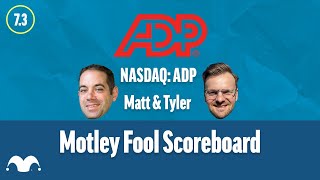Automatic Data Processing (ADP +1.69%) reported fiscal fourth-quarter financial results on July 27. 2017 was a challenging year for the leading provider of human capital management solutions, but ADP's management remains confident that better times are ahead.
ADP results: The raw numbers
|
Metric |
Q4 2017 |
Q4 2016 |
Year-Over-Year Change |
|---|---|---|---|
|
Revenue |
$3.065 billion |
$2.898 billion |
6% |
|
Net earnings from continuing operations |
$266 million |
$282 million |
(6%) |
|
EPS from continuing operations |
$0.59 |
$0.62 |
(5%) |
Data source: ADP Q4 2017 earnings press release.
What happened with ADP this quarter?
Worldwide new business bookings fell 7% in the fourth quarter and 5% for the year. CEO Carlos Rodriguez explained some of the factors impacting these results during a conference call with analysts:
While we are disappointed with this year's overall bookings performance, it's important to look at the underlying dynamics. The clients were concentrated in our mid and upmarkets and the challenges were due in large part to growing over the strong fiscal 2016 sales of solutions that assist our clients in complying with the Affordable Care Act. Despite these challenges, the sales opportunities within the mid and upmarket continue to demonstrate a solid environment with positive growth prospects.

The Affordable Care Act was a boon for ADP's business in fiscal 2016, but it also made for tough comparisons in 2017. Image source: Getty Images.
Revenue rose 6% year over year to $3.1 billion, as organic growth of 7% was partially offset by ADP's sale of its consumer health spending account and COBRA businesses.
PEO services, which is ADP's co-employment division, saw revenue jump 16% to $892 million. Average worksite employees paid increased 12% to more than 485,000. In turn, PEO services earnings from continuing operations leapt 17% to $107 million, as segment margin improved by 10 basis points to 12%.
Revenue in its employer services segment, which includes ADP's human capital management and human resources outsourcing businesses, increased 2% (3% on an organic basis) to $2.3 billion, as the number of employees on ADP clients' payrolls in the U.S. grew 2.1%. Additionally, client revenue retention improved 60 basis points compared to the fourth quarter of 2016. Segment margin, however, decreased 210 basis points to 26.5%, as ADP continues to invest heavily in the business despite slower revenue growth, as noted by Rodriguez:
ADP is built for the long haul. Consistent with our long-term objectives and consistent with conversations we've had with shareholders, we will continue to leverage the strength of our business model and our proven ability to execute by making smart investments that enhance our service capabilities, our sales force and deliver best-in-class cloud solutions. We believe these efforts will continue to drive sustained long-term success for our clients, our associates and our shareholders.
All told, ADP's earnings per share from continuing operations -- adjusted to exclude restructuring charges -- declined 4% to $0.66.
Looking forward
ADP issued a financial outlook for fiscal 2018 including:
- full-year revenue growth of 5% to 6% compared to fiscal 2017 revenue of $12.4 billion,
- growth in worldwide new business bookings of 5% to 7% compared to the $1.65 billion sold in fiscal 2017, and
- adjusted diluted earnings-per-share growth of 2% to 4% compared to adjusted EPS of $3.70 in 2017.
"We finished the year in-line with our expectations, including solid organic revenue growth of 7% benefiting from continued strong performance of our PEO," Rodriguez said in a press release. "We move into fiscal 2018 with confidence in our long-term strategy and will continue to invest in product, service, and sales to advance the value we create for clients and capture market opportunities."






